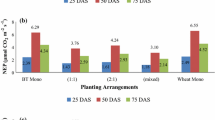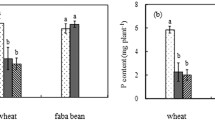Abstract
The effect of mixed intercropping of field pea (Pisum sativum L.) and spring barley (Hordeum vulgare L.), compared to monocrop cultivation, on the yield and crop-N dynamics was studied in a 4-yr field experiment using 15N-isotope dilution technique. Crops were grown with or without the supply of 5 g 15N-labeled N m-2. The effect of intercropping on the dry matter and N yields, competition for inorganic N among the intercrop components, symbiotic fixation in pea and N transfer from pea to barley were determined. As an average of four years the grain yields were similar in monocropped pea, monocropped and fertilized barley and the intercrop without N fertilizer supply. Nitrogen fertilization did not influence the intercrop yield, but decreased the proportion of pea in the yield. Relative yield totals (RYT) showed that the environmental sources for plant growth were used from 12 to 31% more efficiently by the intercrop than by the monocrops, and N fertilization decreased RYT-values. Intercrop yields were less stable than monocrop barley yields, but more stable than the yield of monocropped pea. Barley competed strongly for soil and fertilizer N in the intercrop, and was up to 30 times more competitive than pea for inorganic N. Consequently, barley obtained a more than proportionate share of the inorganic N in the intercrop. At maturity the total recovery of fertilizer N was not significantly different between crops, averaging 65% of the supplied N. The fertilizer N recovered in pea constituted only 9% of total fertilizer-N recovery in the intercrop. The amount of symbiotic N2 fixation in the intercrop was less than expected from its composition and the fixation in monocrop. This indicates that the competition from barley had a negative effect on the fixation, perhaps via shading. At maturity, the average amount of N2 fixation was 17.7 g N m-2 in the monocrop and 5.1 g N m-2 in the intercropped pea. A higher proportion of total N in pea was derived from N2 fixation in the intercrop than in the monocrop, on average 82% and 62%, respectively. The 15N enrichment of intercropped barley tended to be slightly lower than of monocropped barley, although not significantly. Consequently, there was no evidence for pea N being transferred to barley. The intercropping advantage in the pea-barley intercrop is mainly due to the complimentary use of soil inorganic and atmospheric N sources by the intercrop components, resulting in reduced competition for inorganic N, rather than a facilitative effect, in which symbiotically fixed N2 is made available to barley.
Similar content being viewed by others
Abbreviations
- MC:
-
monocrop
- IC:
-
intercrop
- PMC:
-
pea monocrop
- BMC:
-
barley monocrop
- PIC:
-
pea in intercrop
- BIC:
-
barley in intercrop
References
Cowell L E, Bremer E and vanKessel C 1989 Yield and N2 fixation of pea and lentil as affected by intercropping and N application. Can. J. Soil Sci. 69, 243–251.
Danso S K A, Zapata F, Hardarson G and Fried M 1987 Nitrogen fixation in fababeans as affected by plant population density in sole or intercropped systems with barley. Soil Biol. Biochem. 19, 411–415.
DeWit C T 1960 On competition. Versl. Landbouwk. Onderzoek. 66, 1–81.
DeWit C T and van denBergh J P 1965 Competition between herbage plants. Neth. J. Agric. Sci. 13, 212–221.
Eaglesham A R J, Ayanaba A, Ranga Rao V and Eskew D L 1981 Improving the nitrogen nutrition of maize by intercropping with cowpea. Soil Biol. Biochem 13, 169–171.
Egsgaard H, Larsen E and Jensen E S 1989 Evaluation of automated determination of nitrogen-15 by on-line combustion. Anal. Chim. Acta 226, 345–349.
Fiedler R and Proksch G 1975 The determination of nitrogen-15 by emission and mass spectrometry: A review. Anal. Chim. Acta 78, 1–62.
Fried M and Middelboe V 1977 Measurement of amount of nitrogen fixed by a legume crop. Plant and Soil 47, 713–715.
Giller K E, Ormesher J and Awah F M 1991 Nitrogen transfer from Phaseolus bean to intercropped maize measured using 15N-enrichment and 15N-isotope dilution methods. Soil Biol. Biochem. 23, 339–346.
Hamel C, Barrantes-Cartín U, Furlan V and Smith D L 1991 Endomycorrhizal fungi in nitrogen transfer from soybean to maize. Plant and Soil 138, 33–40.
Haynes R J 1980 Competitive aspects of the grass-legume: association. Adv. Agron. 33, 227–261.
Izaurralde R C, McGill W B and Juma N G 1992 Nitrogen fixation efficiency, interspecies N transfer, and root growth in barley-field pea intercrop on a Black Chernozemic soil. Biol. Fertil. Soils 13, 11–16.
Jakobsen I and Nielsen N E 1983 Vesicular-arbuscular mycorrhiza in field-grown crops. I. Mycorrhizal infection in cereals and peas at various times and soil depths. New Phytol. 93, 401–413.
Jensen A 1985 Evaluation of VA-mycorrhiza as a parameter in breeding field-peas. In Proceedings of the 6th North American Conference on Mycorrhiza, Oregon, 1984. Ed. RMolina. p 258. Forest Research Laboratory, Oregon, USA.
Jensen E S 1987a Seasonal pattern of growth and nitrogen fixation in field-grown pea. Plant and Soil 101, 29–37.
Jensen E S 1996a Barley uptake of N deposited in the rhizosphere of associated field pea. Soil Biol. Biochem. 28, 159–168.
Jensen E S 1996b Rhizodeposition of N by pea and barley and its effect on soil N dynamics. Soil Biol. Biochem. 28, 65–71.
Jensen E S, Haahr V, Thomsen J D and Sandfær J 1985 Nitrogen Supply of Crops by Biological Nitrogen Fixation. III Intercropping of pea and barley. Risø Report M-2458. Risø, Roskilde, Danmark. 139 p.
Jensen F 1987b Irrigation requirement in various growing phases of peas. Dan. J. Plant Soil Sci. 91, 113–119.
Johnston H W, Sanderson J B and Macleod J A 1978 Cropping mixtures of field peas and cereals in Prince Edward Island. Can. J. Plant Sci. 58, 421–426.
Keeney D R and Nelson D W 1982 Nitrogen — Inorganic forms. In Methods of Soil Analysis Part 2. Chemical and Microbiological Properties. Agron. Monogr. 9, 2nd ed. Ed. A LPage. pp 643–698. ASA, SSSA, Madison, WI.
Martin M P L D and Snaydon R W 1982 Root and shoot interactions between barley and field beans when intercropped. J. Appl. Ecol. 19, 263–272.
Ofori F and Stern W R 1987 Cereal-legume intercropping systems. Adv. Agron. 41, 41–90.
Papastylianou I and Danso S K A 1991 Nitrogen fixation and transfer in vetch and vetch oats mixtures. Soil Biol. Biochem. 23, 447–452.
SAS 1990 SAS Procedures Guide, Version 6 Third Edition, Sas Institute, Cary, NC, USA. 705 p.
Sawatsky N and Soper R J 1991 A quantitative measurement of the nitrogen loss from the root system of field pea (Pisum avense L.) grown in soil. Soil Biol. Biochem. 23, 255–259.
Schjørring J K, Nielsen N E, Jensen H E and Gottschau A 1989 Nitrogen losses from field-grown spring barley plants as affected by rate of nitrogen application. Plant and Soil 116, 167–175.
Snaydon R W and Harris P M 1981 Interactions belowground — the use of nutrients and water. In Proceedings of The International Workshop on Intercropping, Hyderabad, India. Ed. R WWilley. pp 188–201. ICRISAT, Patancherou, India.
Sprent J I and Minchin F R 1985 Rhizobium, nodulation and nitrogen fixation. In Grain Legume Crops. Eds. R JSummerfield and E HRoberts. pp 115–144. Collins, London, UK.
Tobita S, Ito O, Matsunaga R, Rao T P, Rego T J, Johansen C and Yoneyama T 1994 Field evaluation of nitrogen fixation and use of nitrogen fertilizer by sorghum/pigeonpea intercropping on an Alfisoil in the Indian semi-arid tropics. Biol. Fertil. Soils 17, 241–248.
Trenbath B R 1976 Plant interactions in mixed crop communities. In Multiple Cropping. Eds, R IPapendick, P ASanchez and G BTriplett. pp 129–169. ASA Special Puplication No. 27, ASA, SSSA, CSSA, Madison, WI, USA.
Vandermeer J 1989 The Ecology of Intercropping. Cambridge University Press, Cambridge, UK. 237 p.
Wahua T A T and Miller D A 1978 Effects of intercropping on soybean N2-fixation and plant composition on associated sorghum and soybean. Agron. J. 70, 292–295.
Waterer J G, Vessey J K, Stobbe E H and R JSoper 1994 Yield and symbiotic nitrogen fixation in a pea-mustard intercrop as influenced by N fertilizer addition. Soil Biol. Biochem. 26, 447–453.
Willey R W 1979a Intercropping — Its importance and research needs. Part 1. Competition and yield advantages. Field Crop Abstr. 32, 1–10.
Willey R W 1979b Intercropping — Its importance and research needs. Part 2. Agronomy and Research Approaches. Field Crop Abstr. 32, 73–85.
Willey R W and Rao M R 1980 A competitive ratio for quantifying competition between intercrops. Exp. Agric. 16, 117–125.
Witty J F and Giller K 1991 Evaluation of errors in the measurement of biological nitrogen fixation using 15N fertilizer. In Stable Isotopes in Plant Nutrition, Soil Fertility and Environmental Studies. pp 59–72. IAEA, Vienna, Austria.
Author information
Authors and Affiliations
Rights and permissions
About this article
Cite this article
Jensen, E.S. Grain yield, symbiotic N2 fixation and interspecific competition for inorganic N in pea-barley intercrops. Plant Soil 182, 25–38 (1996). https://doi.org/10.1007/BF00010992
Received:
Accepted:
Issue Date:
DOI: https://doi.org/10.1007/BF00010992




